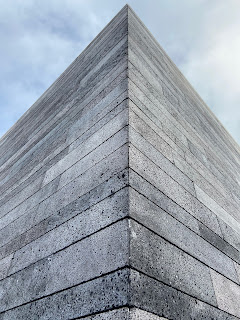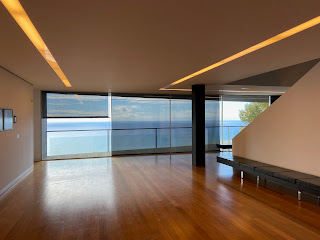Today’s theme is rain avoidance. We decide on a good museum: the Mudas, Museu de Arte Contemporânea de Madeira in Calheta. It is a modern art museum designed by architect is Paulo David in the form of a cliff-top “forteleza”, as we’ve seen in a few locations around Madeira. The stone seems to be a pumice-like, honed volcanic rock that we’ve seen in a more natural, ‘nubby’ form all over Funchal, on landscaping dividers and feature walls.
The top is a level lookout over a striped garden of local shrubs and grasses. Into this stone block, the architect cuts a maze of framed views and balconies, where guests can take in the terraced hills and the marina at Calheta.
The galleries are well-scaled to the artwork, with tall slots of natural lights illuminating the end walls. As on the upper level, tight connecting spaces unfold into wider galleries. The lighting works as an inverse of the planting stripes, with energetic bolts illuminating the stair rails.
However, most of the galleries are closed; there is some snafu with the collection. It’s a real shame as the building and the collection on display are fascinating. Perhaps designing a museum like a fort is a stretch - but forts react to and fit a landscape as much as they are imposed upon it. These are places of refuge, for people and things, their stories and their preservation. Best not to let these places fall into abandoned decay.
With our museum trip is cut short and we are sent back out into the weather. Luckily it is starting to clear, so we head down the coast to see what we can see. We arrive at the Ponta do Pargo and the Miradouro do Fio. There is a little cafe and a kind of paved platform. Look closely at the last image there, and you’ll see the “farol” (lighthouse) at the top of the escarpment.
The Farol do Ponta do Pargo is a rather dumpy beacon, but it marks the southwestern tip of the island. Views from the “miradouro” there are excellent. The grassy, flat field simply drops away. I hope they don’t lose too may cows - the tourists who wander beyond the warning signs can watch out for themselves.
Now we turn north, along the western coast, and signs of the recent fires are all around. The smell of the charcoal is fresh, and a reminder of California. The scarring goes on for miles until we pass Achadas da Cruz, turn eastward, and continue along the north coast. We reach Porto Moniz in a heavy squall, another regret as I really would like to see the natural pools there. So we continue on.
The coast highway along the north has been re-routed into tunnels.The old highway is still there, just gated with slash-circle signs. At each tunnel entrance we can see the old road off to the left, with scattered fallen rocks, slowly fading into ruin. As we exit the tunnel near São Vicente, the downpours have created a rushing cascade just to one side of the road, as if the hill has sprung a leak. We decide to stop and have lunch here and wait out the rain.
As we reach the interior mountains, and approach Serra da Água, we see the bright roof of an enormous lodge; this is the Estalagem Encumeada. It seems to be a hot spot for serious hikers, but it is truly in the middle of nowhere. On the other hand, the mountain views are absolutely breathtaking.
Our last stop before we reach the coast is a place called the Dorisol Pousada Dos Vinhaticos. It’s a stunning little inn, with views of some of the most unique formations in the valley. This seems just as much a place for hikers and as for poets.


































No comments:
Post a Comment